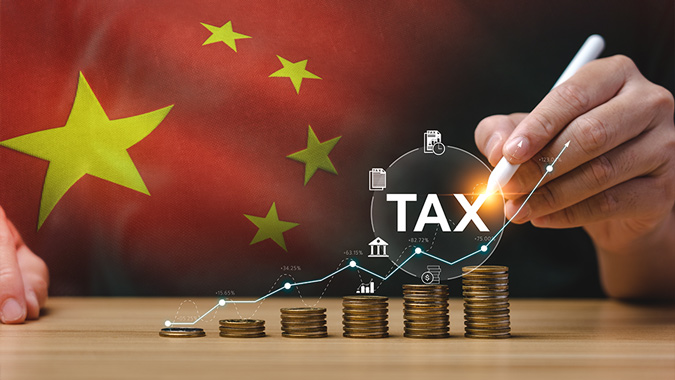China
January 2024 Monthly Tax Update for China

The State Taxation Administration has issued a circular clarifying tax filing and payment deadlines for 2024. Taxpayers must file and pay taxes within 15 business days after the end of each month or quarter. For more details and a calendar format, read the China Tax Filing and Payment Deadlines for 2024 article by China Briefing.
The State Taxation Administration (STA) has released the Circular of the General Office of the State Taxation Administration on the Tax Filing and Payment Deadlines for 2024, clarifying the tax filing and payment deadlines for taxpayers who are required to complete tax filing and payment within 15 business days upon the end of each month or quarter.
To learn more about what taxes are subject to these tax filing and payment deadlines and download the “China Tax Filing and Payment Deadlines for 2024” in calendar format, please read our China Briefing article here: China Tax Filing and Payment Deadlines for 2024
This article is republished from China Briefing. Read the rest of the original article.
China Briefing is written and produced by Dezan Shira & Associates. The practice assists foreign investors into China and has done since 1992 through offices in Beijing, Tianjin, Dalian, Qingdao, Shanghai, Hangzhou, Ningbo, Suzhou, Guangzhou, Dongguan, Zhongshan, Shenzhen, and Hong Kong. Please contact the firm for assistance in China at china@dezshira.com.
China
Outlook on Bilateral Trade and Investment between China and United Arab Emirates (UAE)

The UAE and China have a strong partnership, with the UAE being China’s top trade partner in the Arab world. Both countries collaborate on various sectors like logistics and technology, showcasing mutual commitment to economic growth and global cooperation. High-level trade and investments continue to drive their relationship.
The UAE and China share a robust partnership integral to both countries’ development and foreign policy goals, exemplifying a model of collaboration. Bilateral trade thrives, with the UAE as China’s top trade partner in the Arab world, while investments span key sectors like logistics and technology. This comprehensive strategic partnership continues to evolve, showcasing mutual commitment to economic growth and global cooperation.
The United Arab Emirates (UAE) holds a significant position in China’s trade and commercial connections within the Middle East, particularly in the Arab Gulf region. This partnership is integral to China’s broader strategic initiatives, including the Belt and Road Initiative (BRI), which the UAE actively supports.
Additionally, the UAE plays a crucial role in advancing China’s foreign policy objectives, such as enhancing South-South cooperation, particularly in technical collaboration among developing nations and the Global South in areas like resources and technology.
In this article, we delve into the dynamics of bilateral trade and investment between the UAE and China, exploring the key factors driving their economic relationship and the opportunities it presents for mutual growth and prosperity.
China and the UAE first established their diplomatic relations in 1984. While China has an embassy in Abu Dhabi and a consulate general in Dubai, the UAE has a consulate general in Hong Kong and an embassy in Beijing. China and the UAE have long been close partners, collaborating extensively on economic, political, and cultural fronts.
In 2018, Chinese President Xi Jinping went on a state visit to the UAE, making history as the first Chinese head of state to visit the country in the previous 29 years. The visit was instrumental in lifting bilateral relations to a ‘comprehensive strategic partnership’.
High-level trade has always been the foundation of bilateral ties. Bilateral commerce between China and the UAE reached new heights in 2021, surpassing US$75.6 billion. Additionally, as of 2022, about 6,000 Chinese businesses operate in the UAE, with a sizable Chinese population working primarily in the infrastructure and energy sectors. The UAE is also China’s second-largest economic partner in the Middle East, after Saudi Arabia.
This article is republished from China Briefing. Read the rest of the original article.
China Briefing is written and produced by Dezan Shira & Associates. The practice assists foreign investors into China and has done since 1992 through offices in Beijing, Tianjin, Dalian, Qingdao, Shanghai, Hangzhou, Ningbo, Suzhou, Guangzhou, Dongguan, Zhongshan, Shenzhen, and Hong Kong. Please contact the firm for assistance in China at china@dezshira.com.
China
2024 Tax Incentives for Manufacturing Companies in China

China offers various tax incentives to boost the manufacturing industry. The Ministry of Finance and State Tax Administration provide guidelines on eligibility and policies. VAT exemptions and refunds are available for companies producing specific goods or services, with a monthly refund option for deferred taxes.
China implements a wide range of preferential tax policies to encourage the development of the country’s manufacturing industry. We summarize some of the main manufacturing tax incentives in China and explain the basic eligibility requirements that companies must meet to enjoy them.
China’s Ministry of Finance (MOF) and State Tax Administration (STA) have released guidelines on the main preferential tax and fee policies available to the manufacturing industry in China. The guidelines consolidate the main preferential policies currently in force and explain the main eligibility requirements to enjoy them.
To further assist companies in identifying the preferential policies available to them, we have outlined some of the main policies currently available in the manufacturing industry, including links to further resources.
For instance, VAT is exempted for:
Companies providing the following products and services can enjoy immediate VAT refunds:
Companies in the manufacturing industry that meet the conditions for deferring tax refunds can enjoy a VAT credit refund policy. The policy allows companies to receive the accumulated deferred tax amount every month and the remaining deferred tax amount in a lump sum.
The policy is not exclusive to the manufacturing industry and is also available to companies in scientific research and technical services, utilities production and supply, software and IT services, and many more.
This article is republished from China Briefing. Read the rest of the original article.
China Briefing is written and produced by Dezan Shira & Associates. The practice assists foreign investors into China and has done since 1992 through offices in Beijing, Tianjin, Dalian, Qingdao, Shanghai, Hangzhou, Ningbo, Suzhou, Guangzhou, Dongguan, Zhongshan, Shenzhen, and Hong Kong. Please contact the firm for assistance in China at china@dezshira.com.
China
Exploring the Revamped China Certified Emission Reduction (CCER) Program: Potential Benefits for International Businesses

Companies in China must navigate compliance, trading, and reporting within the CCER framework, impacting operations and strategic objectives. The program focuses on afforestation, solar, wind power, and mangrove creation, offering opportunities for innovation and revenue streams while ensuring transparency and accuracy. The Ministry of Ecology and Environment oversees the program.
As companies navigate the complexities of compliance, trading, and reporting within the CCER framework, they must also contend with the broader implications for their operations, finances, and strategic objectives.
This article explores the multifaceted impact of the CCER program on companies operating in China, examining both the opportunities for innovation and growth, as well as the potential risks and compliance considerations.
Initially, the CCER will focus on four sectors: afforestation, solar thermal power, offshore wind power, and mangrove vegetation creation. Companies operating within these sectors can register their accredited carbon reduction credits in the CCER system for trading purposes. These sectors were chosen due to their reliance on carbon credit sales for profitability. For instance, offshore wind power generation, as more costly than onshore alternatives, stands to benefit from additional revenue streams facilitated by CCER transactions.
Currently, primary buyers are expected to be high-emission enterprises seeking to offset their excess emissions and companies aiming to demonstrate corporate social responsibility by contributing to environmental conservation. Eventually, the program aims to allow individuals to purchase credits to offset their carbon footprints. Unlike the mandatory national ETS, the revamped CCER scheme permits any enterprise to buy carbon credits, thereby expanding the market scope.
The Ministry of Ecology and Environment (MEE) oversees the CCER program, having assumed responsibility for climate change initiatives from the National Development and Reform Commission (NDRC) in 2018. Verification agencies and project operators are mandated to ensure transparency and accuracy in disclosing project details and carbon reduction practices.
On the second day after the launch on January 23, the first transaction in China’s voluntary carbon market saw the China National Offshore Oil Corporation (CNOOC), the country’s largest offshore oil and gas producer, purchase 250,000 tons of carbon credits to offset its emissions.
This article is republished from China Briefing. Read the rest of the original article.
China Briefing is written and produced by Dezan Shira & Associates. The practice assists foreign investors into China and has done since 1992 through offices in Beijing, Tianjin, Dalian, Qingdao, Shanghai, Hangzhou, Ningbo, Suzhou, Guangzhou, Dongguan, Zhongshan, Shenzhen, and Hong Kong. Please contact the firm for assistance in China at china@dezshira.com.









